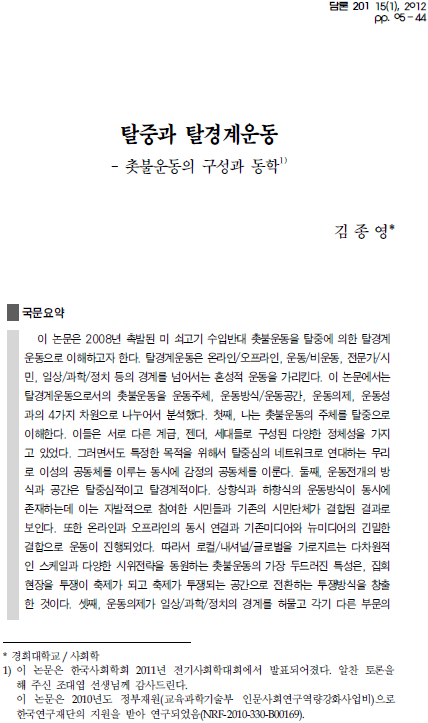
| Title |
: The Post-mass and Trans-Boundary Movement: The Construction and Dynamics of the 2008 Candlelight Movement |
| Date |
: 2012. 2. |
| Journal title |
: Discourse 201 |
| Author |
: Kim, Jongyoung |
| Contact us |
: csts@khu.ac.kr |
| Abstract |
: This paper interprets the 2008 candlelight movements in Korea, caused by the import of American beef, as a trans-boundary movement mobilized by the post-mass. Here "trans-boundary movement" means a collective action that goes beyond the binaries of online/offline, movement/non-movement, protest/festival, and citizen/expert, and that transcends any categorical distinctions among daily life, science and politics. In this paper, I examined the candlelight movement in terms of four aspects: its subject, its repertoire and site, its issue, and its effect. Based upon findings gained from that research, first of all, I conceptualized movement participants as the ``post-mass.`` The reason is that participants in the movement do not conform to contemporary theories of the ``multitude`` and the middle class. The post-mass designates a decentralized and networked group whose members transcend class and gender, age and generation, race and region, and many other types of social grouping and forming solidarities for a certain purpose. Such groups are hybrid and plural, but they lack coherence and teleology. The community they form is emotional as well as rational. Second, the mobilizing structure of the candlelight movement was decentered, and there was no boundary in the space and site that its movement participants deployed their struggle. Its operation relied on both bottom-up and top-down approaches as it combined citizens` voluntary participation and movement organizations` strategic involvement. The candlelight movement also defied such categories of online / offline, old media / new media, and local / national / global. In the demonstrations, diverse strategies were mobilized and the struggle was transformed into a carnival. Third, the movement issues were hybridized, going beyond the distinctions between daily life, science, and politics. In the processes of setting and then disseminating an agenda, citizens, experts, and media were allied. Because the issues were complex and mixed, multiple types of cooperation and coordination took place among diverse scientific, social, legal, and economic areas. Fourth, the movement`s long-term effects were multi-dimensional, leading to political, institutional, organizational, and biological changes. The candlelight protest not only led to political, but also to legal and institutional changes, especially in the area of food safety. At the same time, movement organizations gained momentum that attracted more members and produced more movement activities, and many new movement organizations were founded to pursue concerns initially raised by the candlelight protest. Citizens who participated in the movement were changed into different subjects as they engaged in political and social issues: they empowered themselves, believing that they could change society and their lives. In conclusion, it might be said that the trans-boundary movement by this post-mass contributed to the diversification of social movements in Korea, and thus that it calls for more studies on the post-mass and on trans-boundary movements this case study addressed.
Click the following link for downloading the article: http://kiss.kstudy.com/journal/thesis_name.asp?tname=kiss2002&key=3026547 |
|

